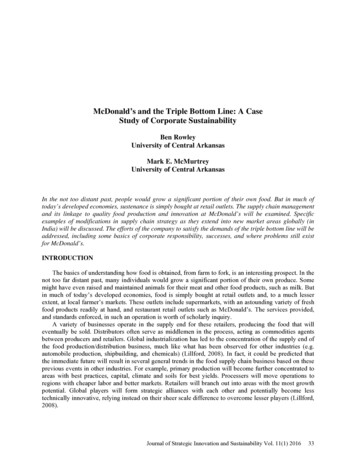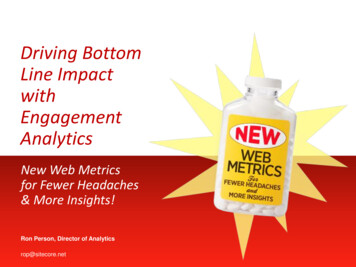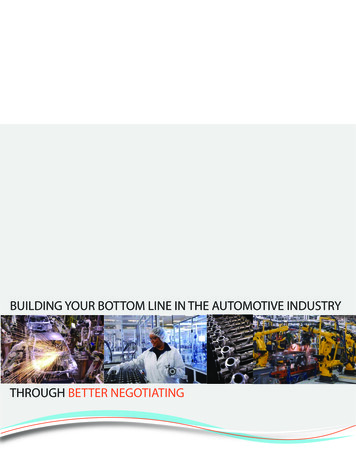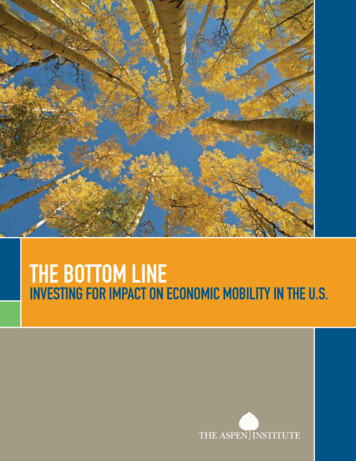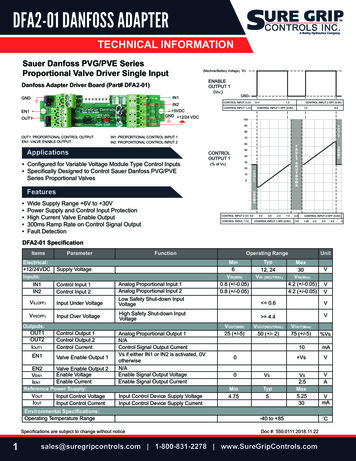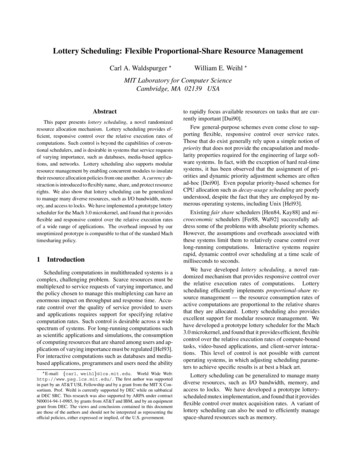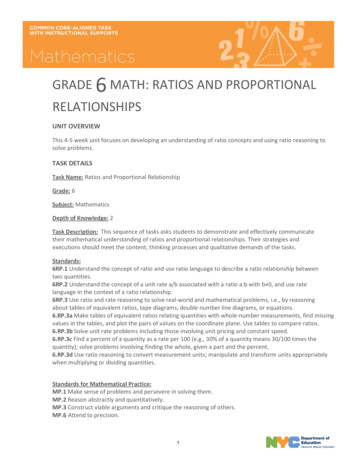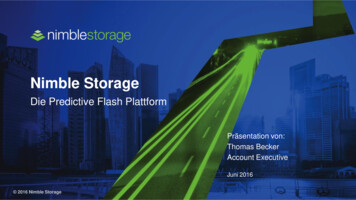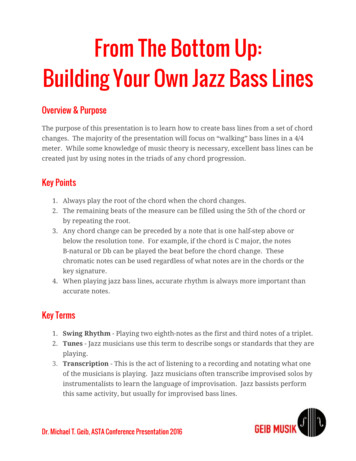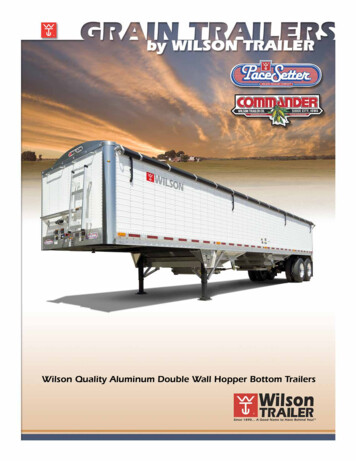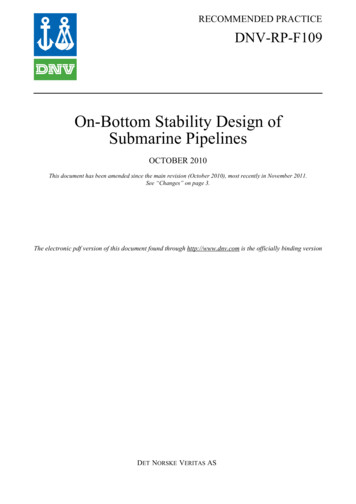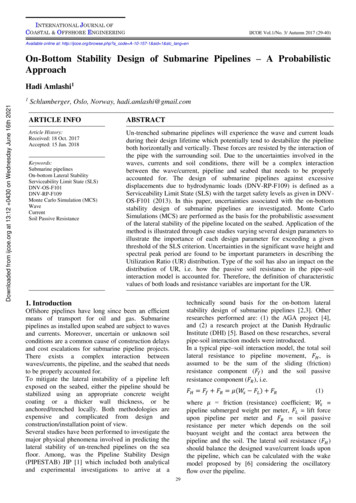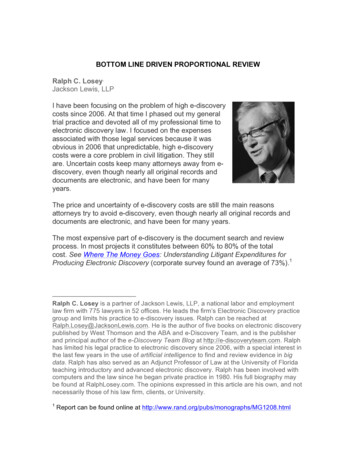
Transcription
BOTTOM LINE DRIVEN PROPORTIONAL REVIEWRalph C. LoseyJackson Lewis, LLP I have been focusing on the problem of high e-discoverycosts since 2006. At that time I phased out my generaltrial practice and devoted all of my professional time toelectronic discovery law. I focused on the expensesassociated with those legal services because it wasobvious in 2006 that unpredictable, high e-discoverycosts were a core problem in civil litigation. They stillare. Uncertain costs keep many attorneys away from ediscovery, even though nearly all original records anddocuments are electronic, and have been for manyyears.The price and uncertainty of e-discovery costs are still the main reasonsattorneys try to avoid e-discovery, even though nearly all original records anddocuments are electronic, and have been for many years.The most expensive part of e-discovery is the document search and reviewprocess. In most projects it constitutes between 60% to 80% of the totalcost. See Where The Money Goes: Understanding Litigant Expenditures forProducing Electronic Discovery (corporate survey found an average of 73%).1Ralph C. Losey is a partner of Jackson Lewis, LLP, a national labor and employmentlaw firm with 775 lawyers in 52 offices. He leads the firm’s Electronic Discovery practicegroup and limits his practice to e-discovery issues. Ralph can be reached atRalph.Losey@JacksonLewis.com. He is the author of five books on electronic discoverypublished by West Thomson and the ABA and e-Discovery Team, and is the publisherand principal author of the e-Discovery Team Blog at http://e-discoveryteam.com. Ralphhas limited his legal practice to electronic discovery since 2006, with a special interest inthe last few years in the use of artificial intelligence to find and review evidence in bigdata. Ralph has also served as an Adjunct Professor of Law at the University of Floridateaching introductory and advanced electronic discovery. Ralph has been involved withcomputers and the law since he began private practice in 1980. His full biography maybe found at RalphLosey.com. The opinions expressed in this article are his own, and notnecessarily those of his law firm, clients, or University.1Report can be found online at http://www.rand.org/pubs/monographs/MG1208.html
For that reason, although I practice in all areas of electronic discovery law, myefforts to control costs have focused on document review.2Two Different Review TasksThe review costs in turn arise primarily from two legal activities:31. Search for and identification of the likely responsive or relevantdocuments. (For convenience and simplicity purposes this paper will referonly to relevance henceforth, and not responsiveness, although the authorrecognizes there can be differences.) This is a binary decision, yes or noas to relevance. This type of review is often called first pass review.42. Study of the documents identified as likely relevant to determine whichmust be withheld, logged, redacted, and/or labeled to protect a client'sconfidential information, such as privileged communications. Thesubsequent reviews can also include specific issue tagging work unrelatedto confidentiality concerns. Documents not identified as relevant are notincluded in these further reviews, but may be subject to sampling forquality assurance purposes.5The second reviews for client confidentiality purposes can be very problematic,expensive, and risk-filled.6 For instance in Tampa Bay Water v. HDR2There are essentially ten tasks that lawyers perform in e-discovery, three of whichpertain to document review. They are described in the Electronic Discovery BestPractices found at EDBP.com. The three types of services pertaining to documentreview can be found at: http://www.edbp.com/search-review/. The functions performedby electronic discovery vendors, which includes non-legal services such as dataprocessing, are outlined in the Electronic Discovery Reference Model found atEDRM.net.3Foran example of this industry standard two-step practice see Gabriel Techs., Corp. v.Qualcomm, Inc., No. 08CV1992 AJB (MDD), 2013 WL 410103 at *10 (S.D. Cal. Feb. 1,2013) (cost award allowed to prevailing party of 2,829,349.10 for first-pass review bySMEs of one million documents and another 391,928.91 for a second review bycontract lawyers.)4It is included in the EDBP as step seven and described as Computer Assisted Review(CAR) found at: d-review/.5Itis included in the EDBP as step eight and described as Protections found at:http://www.edbp.com/search-review/.6Mt.Hawley Ins. Co. v. Felman Production, Inc., 2010 WL 1990555 (S.D. W. Va. May18, 2010) (privilege documents accidentally produced resulting in waiver of privilege inCopyright Ralph Losey 20132
Engineering, Inc., a large construction case involving millions of documentsreviewed for possible production, both sides inadvertently produced thousands ofprivileged documents to each other.7 They did so despite expenditures of tens ofmillions of dollars for traditional attorney review of each document beforeproduction.My analysis and experiments with cost controls since 2006 have focused on boththe cost of the initial relevancy review, and the cost of the final protectionreviews. Great progress has been made in the last several years in lowering thecost of first-pass relevancy reviews, especially when using artificial intelligence(“AI”) enhanced software. Improvements have also been made in the secondreview costs, but not nearly as dramatic. Although some advocate for theelimination of second pass review to save expenses, and reliance onconfidentiality and clawback agreements only for protection of confidential clientdocuments, most litigants today are unwilling to take the risks involved.At the present time, in most cases, virtually no corporate clients are willing todispense with final manual review of documents selected for production andrely solely on automated software for protections. The likelihood of error is simplystill too high for this to be an acceptable risk in most cases for most clients. Thedamage caused by disclosure of some privileged communications cannot be fullyrepaired by clawback agreements.8spite of sophisticated counsel employing elaborate safeguards). Also see DiabetesCenters of America, Inc. v. Healthpia America, Inc., 2008 U.S. Dist. LEXIS 8362, 2008WL 336382 (S.D. Tex. Feb. 5, 2008) (production errors made by both sides); Danis v.USN Communications, Inc., 2000 WL 1694325 (N.D. Ill. 2000) ( 10,000 fine imposedagainst CEO personally when the young general counsel he hired to supervise ediscovery was grossly negligent);7Tampa Bay Water v. HDR Engineering, Inc. Case No. 8:08-CV-2446-T-27TBM. (M.D.Fl. November 2, 2012) (also found at 2012 U.S. Dist. LEXIS 157631 and 2012 WL5387830). The plaintiff alone inadvertently produced 23,000 privileged documents. Theprevailing defendant in this case was awarded over twenty million dollars in fees andcosts. Of this sum 3,100,000 was awarded as a cost for e-discovery vendor processingand hosting of 2.7 million documents for review. Another 4,590,000 ( 1.70 per file) isestimated to have been spent by one defendant in attorney fees to review thedocuments. See Losey, R., 3.1 Million e-Discovery Vendor Fee Was Reasonable in a 30 Million Case (e-Discovery Team, Aug. 4, 2013) found at n-case/#comment-60139.8See: FN 4. Also see: Brookfield Asset Management, Inc. v. AIG Financial ProductsCorp., 2013 WL 142503 (S.D.N.Y. Jan. 7, 2013); Losey, R., Another ClawbackCopyright Ralph Losey 20133
As I explained in my series Secrets of Search, Parts One, Two and Three, thelatest AI enhanced software is far better than keyword search, but not yet goodenough to allow for a fully automated approach to protection review.9 Based onmy informal surveys and discussions with attorneys around the country, I havefound that confidentiality reviews are only omitted in certain non-litigationcircumstances, such as when making corporate merger related productions tothe government, or in cases where the data under review is very unlikely tocontain confidential information, such as old data of an acquired company. Also, Ihave seen it done in bankruptcy cases, or by litigants in any type of case whootherwise simply could not afford to respond properly to discovery requests.Although AI enhanced review is not good enough, yet, to rely on exclusively forprotection review, it is certainly up to the task of first pass relevancy review.10Attorneys should also use AI enhanced search to speed up the second passmanual review for protections.Of course, it is the litigant's data and their confidential information, so if a litigant(or third party responding to a subpoena), really does not care about disclosureof confidential information in any particular data set, and is not required by law toprotect the confidential information, and if they want to rely on claw back ordersand confidentiality agreements alone, then that is their right. They may instructtheir attorneys to skip this step for cost saving purposes. If you are an attorneyreceiving such an instruction, I recommend that you confirm that instruction inwriting. You should also provide a full, detailed, written disclosure of the risksinvolved. Make sure the instruction is based on the client’s full understanding thatonce a bell has been rung, it cannot be un-rung, and that, for instance, waiver ofonce privileged attorney-client communications may open the door to waiver ofothers.Enforcement Order Shows the Importance of the Selection of Quality Vendors found e-selection-of-quality-vendors/9The three part essay on Search is available online in one document found ecrets of search 2012 consolidated.pdf10For a description of what I mean by AI enhanced search, which is also commonlycalled Predictive Coding, Technology Assisted Review (TAR), or Computer AssistedReview (CAR) see my page describing CAR found at http://e-discoveryteam.com/car/.Also see the descriptions for step seven in the EDBP at http://www.edbp.com/searchreview/.Copyright Ralph Losey 20134
The Idea of Bottom Line Driven ReviewAfter two years of analysis of the review cost problem I came up with an idea in2008 that looked promising. It is simple in concept, which is one of its strengths(although its implementation can sometimes be complex). I have since testedand refined this method in two law firms with multiple types of cases andinvestigations. I have also spoken about this approach with many otherattorneys, judges, and law professors, and taught this method at multiple CLEevents around the country.11 I call it Bottom Line Driven Proportional Reviewand Production. A more technical description for it, the one I used in a legalmethods patent application, is: System and Method for Establishing,Managing, and Controlling the Time, Cost, and Quality of Information Retrievaland Production in Electronic Discovery. But I usually just call it Bottom LineDriven Review.The Bottom Line of ProductionsThe bottom line in e-discovery production is what it costs.Believe me fellow lawyers, clients care about that . alot! In Bottom Line Driven Proportional Review everythingstarts with the bottom line. What is the production goingto cost? Despite what some lawyers and vendors maytell you, it is not an impossible question to answer. Ittakes an experienced lawyer’s skill to answer, but after awhile, you can get quite good at such estimation. It isbasically a matter of man-hours estimation. With mymethod it becomes a reliable art that you can count on. Itmay never be exact, but the ranges can usually bepredicted, subject of course to the target changing after11I am going to explain the idea here with enough detail for attorneys experienced in ediscovery to be able to try it out. I urge you to do so. I have been working and trainingthe attorneys in my current law firm, Jackson Lewis, in this for years. We know that itworks in all types of employment law cases, federal and state, large and small,especially when coupled with the doctrine of proportionality (also explained in thisessay). In my prior law firm, Akerman Senterfitt, the method was tested and refined inmultiple types of commercial litigation. Time and conflict checks permitting, I can consultand assist attorneys outside of my firm on Bottom Line Driven Review, especially when itinvolves the use of artificial intelligence enhanced software (often called predictivecoding) to search for evidence in big data. That is my current area of special interest andBottom Line Driven Review is particularly effective in large cases.Copyright Ralph Losey 20135
the estimate is given. If the complaint is amended, or different evidence becomesrelevant, then a change order may be required for the new specifications.Price estimation is second nature to me, and an obvious thing to do before youbegin work on any big project. I think that is primarily because I worked as aconstruction estimator out of college to save up money for law school back in theseventies. Estimating legal review costs is basically the same thing, projectingmaterials and labor costs. In construction you come up with prices per squarefoot. In e-discovery you estimate prices per file, as I will explain in detail in thisessay.My new strategy and methodology is based on the bottom line. It is based onprojected review costs, defensible culling, and best practices of AI enhancedreview. Under this method the producing party determines the number ofdocuments to be subjected to costly reviews by calculating backwards from thebottom line of what they are willing, or required, to pay for the production.Setting a Budget Proportional to the CaseThe process begins by the producin
Ralph C. Losey Jackson Lewis, LLP I have been focusing on the problem of high e-discovery costs since 2006. At that time I phased out my general trial practice and devoted all of my professional time to electronic discovery law. I focused on the expenses associated with those legal services because it was obvious in 2006 that unpredictable, high e-discovery costs were a core problem in .
